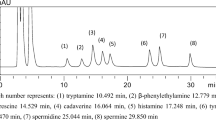Abstract
Bobcat (Lynx rufus) urine reduces scent-marking activity of woodchucks (Marmota monax) and feeding activity of snowshoe hares (Lepus americanus) and deer (Odocoileus virginianus, O. hemionus). In order to identify the semiochemicals responsible for these behavior modifications, a dichloromethane extract of the bobcat urine was analyzed by GC-MS. Among the known compounds identified in the extract are phenol, indole, dimethyl sulfone, and 3-mercapto-3-methylbutanol. Compounds for which spectroscopic data are presented for the first time include one sulfide, two disulfides, and two trisulfides. The sulfur compounds are derived from an amino acid,S-(l,1-dimethyl-3-hydroxypropyl)cysteine (“felinine”), which was identified several years ago in the urine of the domestic cat (Felis domesticus).
Similar content being viewed by others
References
Bailey, S., Bunyan, P.J., andPage, J.M.J. 1979. Variation in the levels of some components of the volatile fraction of urine from capative red foxes (Vulpes vulpes) and its relationships to the state of the animal, pp. 391–403,in D. Müller-Schwarze and R. M. Silverstein (eds.). Chemical Signals: Vertebrates and Aquatic Invertebrates. Plenum, New York.
Baines, D.A.,Faulkes, C. G.,Tomlinson, A.J.,andNing, P.C.Y.K. 1988. Eur. Pat. Appl. EP 280,443. August 31, 1988.
Brinck, C., Erlinge, S., andSandell, M. 1983. Anal sac secretion in mustelids.J. Chem. Ecol. 9:727–745.
Crump, D.R. 1980a. Thietanes and dithiolanes from the anal gland of the stoat (Mustela erminea).J. Chem. Ecol. 6:341–347.
Crump, D.R. 1980b. Anal gland secretion of the ferret (Mustela putorius formaFuro).J. Chem. Ecol. 6:837–844.
Fulk, G.W. 1972. The effect of shrews on the space utilization of voles.J. Mammal. 53:461–478.
Gorman, M.L. 1984. The responses of prey to stoat (Mustela erminea) scent.J. Zool. (London) 202:419–423.
Jackman, L.M., andSternhell, S. 1969. Applications of Nuclear Magnetic Resonance Spectroscopy in Organic Chemistry, 2nd ed. Pergamon Press, Oxford, England.
Jorgenson, J.W., Novotny, M., Carmack, M., Copland, G.B., Wilson, S.R., andWhftten, W.K. 1978. Chemical scent constituents in the urine of the red fox (Vulpes vulpes L.) during the winter season.Science 199:796–798.
Joulain, D., andLaurent, R. 1989. The catty odour in black-currant extracts versus the black-currant odour in cat's urine?, p. 87,in S.C. Bhattacharyya, N. Sen, and K.L. Sethi (eds.). 11th International Congress of Essential Oils, Fragrances and Flavours, New Delhi, India, November 12–16, 1989. Oxford & IBH Publishing Co., New Delhi.
Kjaer, A. 1977. Low molecular weight sulphur-containing compounds in nature: A survey,Pure Appl. Chem. 49:137–152.
Müller-Schwarze, D. 1972. Responses of young black-tailed deer to predator odors.J. Mammal. 53:393–394.
Preti, G., Mutterties, E.L., Furman, J.M., Kennelly, J.J. andJohns, B.E. 1976. Volatile constituents of dog (Canis familiaries) and coyote (Canis latrans) anal sacs.J. Chem. Ecol. 2:177–186.
Singer, A.G., Agosta, W.C., O'Connell, R.J., Pfaffman, C., Bowen, D.V., andField, F.H. 1976. Dimethyl disulfide: An attractant pheromone in hamster vaginal secretion.Science 191:948–950.
Sullivan, T.P. andCrump, D.R. 1984. Influence of mustelid scent gland compounds on suppression of feeding by snowshoe hares (Lepus americanus).J. Chem. Ecol. 10:1809–1821.
Sullivan, T.P., andCrump, D.R. 1986. Avoidance response of pocket gophers (Thomomys talpoides) to mustelid anal gland compounds, pp. 519–531,in D. Duval, D. Müller-Schwarze, and R.M. Silverstein (eds.). Chemical Signals in Vertebrates 4, Plenum, New York.
Sullivan, T.P., Nordstrom, L.O., andSullivan, D.S. 1985a. Use of predator odors as repellents to reduce feeding damage by herbivores. I. Snowshoe hares (Lepus americanus).J. Chem. Ecol. 11:903–920.
Sullivan, T.P., Nordstrom, L.O., andSullivan, D.S. 1985b. Use of predator odors as repellents to reduce feeding damage by herbivores. II. Black-tailed deer (Odocoileus hemionus columbianus).J. Chem. Ecol. 11:921–935.
Sullivan, T.P., Crump, D.R., andSullivan, D.S. 1988a. Use of predator odors as repellents to reduce feeding damage by herbivores. III. Montane and meadow voles (Microtus montanus andMicrotuspennsylvanicus).J. Chem. Ecol. 14:363–377.
Sullivan, T.P., Crump, D.R., andSullivan, D.S. 1988b. Use of predator odors as repellents to reduce feeding damage by herbivores. IV. Northern pocket gophers (Thomomys talpoides)J. Chem. Ecol. 14:379–389.
Sweetman, B.J., Vestling, M.M., Ticaric, S.T., Kelly, P.L., Field, L., Merryman, P., andJaffe, I.A. 1971. Biologically oriented organic sulfur chemistry. 8. Structure-activity relationships of penicillamine analogs and derivatives.J. Med. Chem. 14:868–872.
Swihart, R.K., 1991. Modifying scent-marking behavior to reduce woodchuck damage to fruit trees.Ecol. Appl. 1:98–105.
Swihart, R.K.,Pignatello, J.J.,Mattina, M.J.I. 1991. Predator urines reduce browsing damage by white-tailed deer.J. Chem. Ecol. Accepted.
Westall, R.G. 1953. The amino acids and other ampholytes of urine.Biochem J. 55:244–248.
Wheeler, J.W. 1976. Properties of compounds used as chemical signals, pp. 61–70,in D. Müller-Schwarze and M. Mozell (eds.). Chemical Signals in Vertebrates. Plenum, New York.
Williams, K.I.H., Burstein, S.H., andLayne, D.S. 1966. Dimethyl sulfone: Isolation from human urine.Arch. Biochem. Biophys. 113:251–252.
Wilson, S.R., Carmack, M., Novotny, M., Jorgenson, J.W., andWhitten, W.K. 1978. Δ3-Isopentenyl methyl sulfide. A new terpenoid in the scent mark in the red fox. (Vulpes vulpes).J. Org. Chem. 43:4675–4676.
Author information
Authors and Affiliations
Rights and permissions
About this article
Cite this article
Mattina, M.J.I., Pignatello, J.J. & Swihart, R.K. Identification of volatile components of bobcat (Lynx rufus) urine. J Chem Ecol 17, 451–462 (1991). https://doi.org/10.1007/BF00994344
Received:
Accepted:
Issue Date:
DOI: https://doi.org/10.1007/BF00994344




